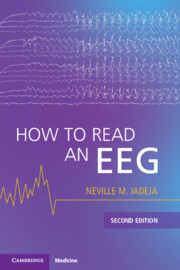Book contents
- How to Read an EEG
- Reviews
- How to Read an EEG
- Copyright page
- Dedication
- Contents
- Figure Contributions
- Foreword to the First Edition
- Preface
- How to Read This Book
- Part I Basics
- Part II Interpretation
- Chapter 7 Approach to EEG Reading
- Chapter 8 Describing Abnormalities
- Chapter 9 Artifacts
- Chapter 10 Normal Variants
- Chapter 11 Sporadic Abnormalities
- Chapter 12 Repetitive Abnormalities
- Chapter 13 Ictal Patterns (Electrographic Seizures)
- Chapter 14 Activation Procedures
- Part III Specific Conditions
- Appendix: How to Write a Report
- Index
- References
Chapter 8 - Describing Abnormalities
from Part II - Interpretation
Published online by Cambridge University Press: 27 September 2025
- How to Read an EEG
- Reviews
- How to Read an EEG
- Copyright page
- Dedication
- Contents
- Figure Contributions
- Foreword to the First Edition
- Preface
- How to Read This Book
- Part I Basics
- Part II Interpretation
- Chapter 7 Approach to EEG Reading
- Chapter 8 Describing Abnormalities
- Chapter 9 Artifacts
- Chapter 10 Normal Variants
- Chapter 11 Sporadic Abnormalities
- Chapter 12 Repetitive Abnormalities
- Chapter 13 Ictal Patterns (Electrographic Seizures)
- Chapter 14 Activation Procedures
- Part III Specific Conditions
- Appendix: How to Write a Report
- Index
- References
Summary
This chapter provides a framework for the reader to describe abnormalities of the electrographic background and foreground. The electrographic background may be described based on symmetry, continuity, voltage, organization, reactivity, and sleep architecture. A waveform or potential abnormality may be described based on its location, occurrence (sporadic or repetitive – rhythmic or periodic), and morphology (slow or sharp wave). Further, this description can be qualified based on modifiers such as prevalence, frequency, duration, and amplitude. When reporting waveforms, the modifiers should precede the key features in your description. [88 words/557 characters]
Information
- Type
- Chapter
- Information
- How to Read an EEG , pp. 76 - 94Publisher: Cambridge University PressPrint publication year: 2025
References
Accessibility standard: WCAG 2.2 AAA
Why this information is here
This section outlines the accessibility features of this content - including support for screen readers, full keyboard navigation and high-contrast display options. This may not be relevant for you.Accessibility Information
Content Navigation
Allows you to navigate directly to chapters, sections, or non‐text items through a linked table of contents, reducing the need for extensive scrolling.
Provides an interactive index, letting you go straight to where a term or subject appears in the text without manual searching.
Reading Order & Textual Equivalents
You will encounter all content (including footnotes, captions, etc.) in a clear, sequential flow, making it easier to follow with assistive tools like screen readers.
You get concise descriptions (for images, charts, or media clips), ensuring you do not miss crucial information when visual or audio elements are not accessible.
You get more than just short alt text: you have comprehensive text equivalents, transcripts, captions, or audio descriptions for substantial non‐text content, which is especially helpful for complex visuals or multimedia.
Visual Accessibility
You will still understand key ideas or prompts without relying solely on colour, which is especially helpful if you have colour vision deficiencies.
You benefit from high‐contrast text, which improves legibility if you have low vision or if you are reading in less‐than‐ideal lighting conditions.
